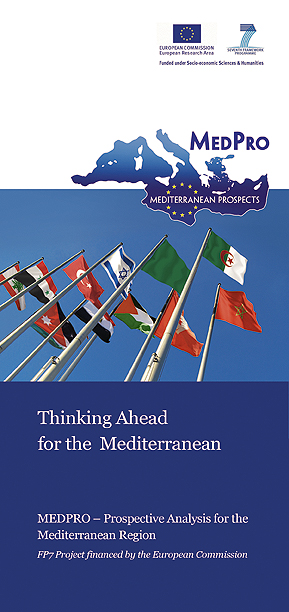- التنسيق العلمي
- الجوغرافية السياسية وحكومة
- الديموغرافيا، والصحة، والشيخوخة
- إدارة البيئة والموارد الطبيعية
- الطاقة، والتخفيف من حدة تغير المناخ
- التكامل الاقتصادي، والتجارة، والاستثمار، والتحليل القطاعي
- الخدمات المالية وسوق رأس المال
- رأس المال البشري، والحماية الاجتماعية، وعدم المساواة والهجرة
- وضع السيناريوهات وتقييم الأثر
- سيناريوهات التكامل الإقليمي والتعاون مع الاتحاد الأوروبي
Population Scenarios and Policy Implications for Southern Mediterranean Countries, 2010-2050
جمعة, 02/08/2013 - 11:23 | by admin
In this MEDPRO Policy Paper, four population scenarios were derived that describe indicators of demographic behaviour for people living in different future political-economic contexts. The paper explores future trends in i) population growth at regional and national levels, ii) working age populations, and iii) elderly populations.
Results show that different scenarios do not have significant effects on population growth, at least up to 2030. This is due to the in-built ‘population momentum’ effect in the relatively young age structures of most southern and eastern Mediterranean countries (SEMCs). In the short term, up to 2030, and depending on which economic-political scenario unfolds, SEMCs are expected to grow from 280 million people to somewhere between 362 and 349 million people. In the same period, EU27 populations will grow only from about 500 to 521 million people. SEMCs vary widely regarding demographic transition profiles so that demographic dividend potentials also vary. Old-age dependency ratios – the share of elderly people in relation to the working age population – are still low compared to EU27 ratios, but will increase after 2035. Should SEMCs’ economies remain politically, economically and environmentally precarious in the coming decades, their relatively low dependency ratios may impose an even higher social and financial burden on economies than the EU countries’ high dependency ratios impose on their economies.
George Groenewold and Joop de Beer are Fellows at Netherlands Interdisciplinary Demographic Institute, The Hague.
| المرفق | الحجم | الطلبات | Last download |
|---|---|---|---|
| MEDPRO PP No 5 WP3 Groenewold.pdf | 668.16 ك.بايت | 1287 | منذ سنتان 43 أسبوعا |
تاريخ المطبوعة:
Tue, 19/03/2013
المؤسسة: NIDI








